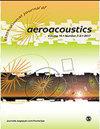射流冲击透水板的声学特性
IF 1.3
4区 工程技术
Q3 ACOUSTICS
引用次数: 0
摘要
本文研究了射流撞击透水板的声学特性和相关的流动特征。将射流与透水板相互作用产生的噪声与冲击在不透水板上的射流和相应的自由射流进行了比较。本研究系统地测量了各种参数,包括孔径、孔隙度和压降,利用Forchheimer方程精确地量化了板的渗透率。重点是研究渗透率对降噪的影响。通过爆破和爆破试验,研究了不同喷嘴压力比和不同喷嘴板间距对渗透率的影响。为了找到声发射的方向性并计算声功率,进行了广泛的方向性研究。研究发现,在亚音速情况下,射流撞击透水板时的总声压级要低于撞击不透水板时的总声压级。还观察到,在超音速射流中插入可渗透板产生的噪声比相应的自由射流小。研究发现,在超音速射流的可渗透板的情况下,大多数音调不存在,而在亚音速和跨音速射流中,与冲击在不渗透板上的射流相比,音调的振幅较小。最后,进行了流量测量和流动可视化研究,以了解导致噪声变化的流动物理特性。研究表明,流动通过多孔板会降低壁面射流速度,从而抑制湍流混合噪声。在可渗透板的前面没有激波振荡被确定为减轻撞击音的原因。本文章由计算机程序翻译,如有差异,请以英文原文为准。
Acoustic characteristics of jets impinging on permeable plates
This article explores the acoustic characteristics and the relevant flow features of jets impinging on permeable plates. Noise generated due to the interaction of the jet with permeable plates is compared with jets impinging on an impermeable plate and the corresponding free jet. This study systematically measures various parameters, including pore size, porosity, and pressure drop, to precisely quantify the permeability of the plates using the Forchheimer equation. The focus is on investigating the impact of permeability on noise reduction. An acoustic study is performed by carrying out blow-up and blow-down tests to find the effect of permeability at different nozzle pressure ratios and different nozzle-plate spacings. An extensive directivity study is conducted to find the directionality of acoustic emissions and calculate acoustic power. It is found that the overall sound pressure level is lower for the jets impinging on the permeable plates compared to the impermeable plates in subsonic cases. It is also observed that the insertion of the permeable plates in supersonic jets generates less noise compared to the corresponding free jet. It is found that most of the tones are absent in the case of permeable plates for supersonic jets, whereas the tones are present with lesser amplitude compared to jets impinging on impermeable plates for subsonic and transonic jets. Finally, flow measurement and flow visualization studies are carried out to understand the flow physics responsible for the noise variance. This study illuminates that the passage of flow through the porous plate results in the reduction of wall-jet velocities, thereby suppressing the turbulent mixing noise. The absence of shock oscillations in front of the permeable plate is identified as the cause of the mitigation of impinging tones.
求助全文
通过发布文献求助,成功后即可免费获取论文全文。
去求助
来源期刊

International Journal of Aeroacoustics
ACOUSTICS-ENGINEERING, AEROSPACE
CiteScore
2.10
自引率
10.00%
发文量
38
审稿时长
>12 weeks
期刊介绍:
International Journal of Aeroacoustics is a peer-reviewed journal publishing developments in all areas of fundamental and applied aeroacoustics. Fundamental topics include advances in understanding aeroacoustics phenomena; applied topics include all aspects of civil and military aircraft, automobile and high speed train aeroacoustics, and the impact of acoustics on structures. As well as original contributions, state of the art reviews and surveys will be published.
Subtopics include, among others, jet mixing noise; screech tones; broadband shock associated noise and methods for suppression; the near-ground acoustic environment of Short Take-Off and Vertical Landing (STOVL) aircraft; weapons bay aeroacoustics, cavity acoustics, closed-loop feedback control of aeroacoustic phenomena; computational aeroacoustics including high fidelity numerical simulations, and analytical acoustics.
 求助内容:
求助内容: 应助结果提醒方式:
应助结果提醒方式:


